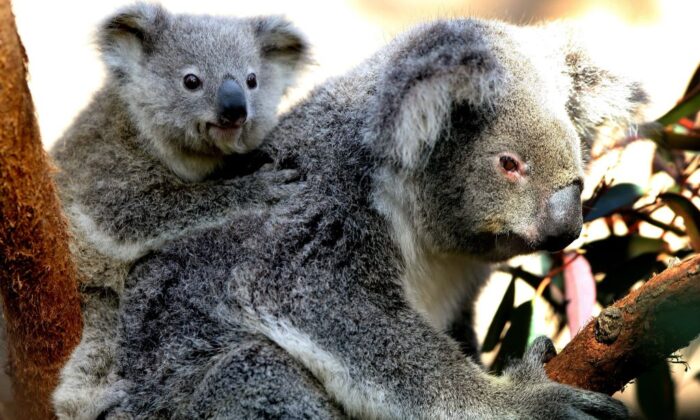While many conservationists support renewable energy, the development of wind farms is causing division among them. Roger Martin, a zoologist living in Queensland’s Atherton Tablelands, is concerned about the impact of wind farms on endangered koalas. He believes that the noise from turbine blades could disrupt koalas’ mating calls, making it difficult for them to locate each other. Despite concerns about the environmental impact and potential health issues associated with wind farms, there is a lack of adequate research on their effects on Queensland’s ecosystems.
Martin argues that the forests in north Queensland are crucial for koalas’ survival, as they provide a cooler habitat that may become increasingly important as temperatures rise. These forests also offer protection from bushfires, which pose a significant threat to koala populations. However, opposing wind farm projects can be challenging for environmentalists due to legal and financial barriers.
Lawyer Dominica Tannock, who is involved in several cases against wind farms, acknowledges the difficulties faced by environmentalists in challenging these projects. She describes the process as a “David and Goliath” situation, where environmentalists struggle to compete with the resources of wind farm companies in legal battles. Despite the obstacles, some conservationists are fighting to protect Queensland’s ecosystems and wildlife from the impacts of wind farms.
Photo courtesy of Steven Nowakowski
Characteristics of an Ideal Wind Farm Site
Queensland is expected to develop a land mass equivalent to Tasmania to accommodate renewable energy projects, including wind farms. This development involves the construction of hundreds of wind turbines, thousands of kilometers of access roads, and the destruction of around 114,000 hectares of forests. Each turbine requires two hectares of land to be cleared for installation.
While Queensland’s desert areas west of the Great Dividing Range have some of the fastest wind speeds in the country, construction in these regions is limited due to high costs of transmission lines and extreme heat that can damage equipment. Environmentalist Steven Nowakowski notes that the lack of wind resources along the coast where electricity is consumed forces developers to scale the heights of coastal and mountainous regions to tap into available wind resources.
The Wildlife Preservation Society of Queensland points out that the state lacks the abundance of wind resources found in Australia’s southern states. Most of the best wind resources in Australia are concentrated in coastal regions in the west, southwest, south, and southeast.
Impact on Nature: Insights from a Botanist
Jeanette Kemp, a former principal botanist for the Queensland government, authored a report on the impact of renewable energy developments on plants and vegetation. She expressed concerns about renewable energy projects encroaching on high-quality native vegetation with significant conservation values.
Kemp highlighted the risks posed to endangered plants and animals, as well as the overlooked problem of weed proliferation resulting from land clearing activities. She also emphasized the hydrological changes caused by road construction for wind farms, which can impact water flow and habitats of vulnerable species like the Magnificent Brood Frog.
Kemp criticized the basic offsets used by developers to mitigate environmental damage, stressing the need for a more comprehensive approach to preserve habitats. She called for a review of current proposals in remnant vegetation areas and advocated for renewable energy projects to be limited to previously cleared land.
Political and Environmental Concerns
Lawyer Tannock raised concerns about foreign companies involved in wind farm projects as a means to offset their pollution from other industries. These companies, often big polluters in mining and processing sectors, build wind farms to appear environmentally friendly and receive carbon credits. This practice allows them to claim carbon neutrality while benefiting from subsidies and saving costs by building near existing transmission lines.
Tannock criticized the Australian government for prioritizing foreign investment in wind farms to boost the economy and gain support for climate change initiatives. She highlighted the conflict between environmental conservation and political interests, as wind farm approvals are driven by political popularity rather than environmental considerations.

Courtesy of Steven Nowakowski
Queensland Senator Matt Canavan, a vocal critic of renewables, claims that thousands of hectares of koala habitat are under threat.
“Despite the promises of environmental benefits, wind energy is causing destruction to our landscapes,” he told The Epoch Times.
Canavan highlighted the significant land footprint of wind farms compared to nuclear energy, citing concerns about the impact on koala habitats.
He expressed particular concern about the Clarke Creek Wind Farm project in Central Queensland, which could jeopardize up to 1,513 hectares of koala habitat.
Canavan condemned this as “environmental vandalism.”
Challenges in Addressing Concerns
Efforts to address environmentalists’ concerns have faced obstacles.
Inquiries to Queensland’s Department of Environment were redirected to the Department of Energy and Climate, and eventually to the federal Department of Climate Change, Energy, and the Environment.
A spokesperson acknowledged the endangered status of koalas in certain regions and emphasized the need for thorough assessments before approving projects that could impact koala populations.
While wind farm projects must include mitigation measures to mitigate environmental harm, the responsibility for site selection lies with renewable energy companies.
The government has invested in scientific studies to enhance environmental data and regulations for renewables.
Community Engagement by Wind Farm Developer
The developer of the Clarke Creek project, Squadron Energy, did not respond to requests for comment.
However, the company recently announced financial support for Safe Haven-Australian Animals Care and Education to aid in the care of injured koalas.
Project director John Macchiusi emphasized the company’s commitment to supporting local communities and wildlife protection efforts.
Safe Haven-AACE expressed gratitude for the funding, which has already contributed to the rehabilitation and release of a koala.
The collaboration aims to safeguard koalas and promote conservation efforts across Queensland.





